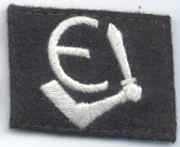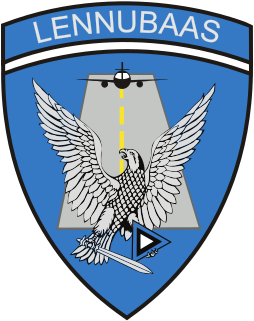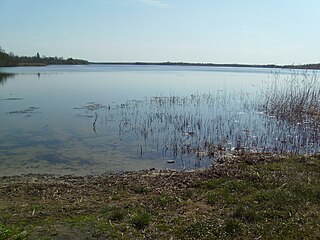
Harju County or Estonian: Harjumaa), is one of the fifteen counties of Estonia. It is situated in Northern Estonia, on the southern coast of the Gulf of Finland, and borders Lääne-Viru County to the east, Järva County to the southeast, Rapla County to the south, and Lääne County to the southwest. The capital and largest city of Estonia, Tallinn, is situated in Harju County.

Stutthof was a Nazi concentration camp established by Nazi Germany in a secluded, marshy, and wooded area near the small town of Sztutowo 34 km (21 mi) east of the city of Danzig in the former territory of the Free City of Danzig. The camp was set up around existing structures after the invasion of Poland in World War II and initially used for the imprisonment of Polish leaders and intelligentsia. The actual barracks were built the following year by prisoners.

The 20th Waffen Grenadier Division of the SS was a foreign infantry division of the Waffen-SS, an armed branch of the German Nazi Party that served alongside but was never formally part of the Wehrmacht during World War II. According to some sources, the division was under Reichsführer-SS Heinrich Himmler's overall command but was not an integral part of the Schutzstaffel (SS). It was officially activated on 24 January 1944, and many of its soldiers had been members of the Estonian Legion and/or the 3rd Estonian SS Volunteer Brigade, which had been fighting as part of German forces since August 1942 and October 1943 respectively. Both of the preceding formations drew their personnel from German-occupied Estonia. Shortly after its official activation, widespread conscription within Estonia was announced by the German occupying authorities. The division was formed in Estonia around a cadre comprising the 3rd Estonian SS Volunteer Brigade, and was initially known as the 20th Estonian SS Volunteer Division.

Klooga concentration camp was a Nazi forced labor subcamp of the Vaivara concentration camp complex established in September 1943 in Harju County, during World War II, in German-occupied Estonia near the village of Klooga. The Vaivara camp complex was commanded by German officers Hans Aumeier, Otto Brennais and Franz von Bodmann and consisted of 20 field camps, some of which existed only for short periods.
Klooga is a small borough in Lääne-Harju Parish in Harju County in northern Estonia. At the 2011 Census, the settlement's population was 1,203, of which the Estonians were 642 (53.4%).

After Nazi Germany invaded the Soviet Union on June 22, 1941, Army Group North reached Estonia in July. Initially the Germans were perceived by most Estonians as liberators from the USSR and its repressions, having arrived only a week after the first mass deportations from the Baltic States. Although hopes were raised for the restoration of the country's independence, it was soon realized that they were but another occupying power. The Germans pillaged the country for their war effort and unleashed The Holocaust in Estonia during which they and their collaborators murdered tens of thousands of people. For the duration of the occupation, Estonia was incorporated into the German province of Ostland.
The 144th Guards Yelnya Red Banner Order of Suvorov Motor Rifle Division is a motorized infantry division of the Russian Ground Forces, reestablished in 2016 with its headquarters at Yelnya.

Vaivara was the largest of the 22 concentration and labor camps established in Estonia by the Nazi regime during World War II. It had 20,000 Jewish prisoners pass through its gates, mostly from the Vilna and Kovno Ghettos, but also from Latvia, Poland, Hungary and the Theresienstadt concentration camp. Vaivara was one of the last camps to be established. It existed from August 1943 to February 1944.
Zew Wawa Morejno was a Polish and American rabbi.

Ämari Air Base is a military airbase in Harjumaa, Estonia located 7 km (4.3 mi) south of Lake Klooga and 20 nautical miles southwest of Tallinn. The length of the runway does not include a 250 m (820 ft) overrun at each end.
A number of war crimes trials were held in the 1960s in Soviet Estonia. The best-known trial was brought in 1961, by the local Soviet authorities against Estonian collaborators who had participated in the execution of the Holocaust during the German occupation (1941–1944). The accused were charged with murdering up to 5000 German and Czechoslovakian Jews and Romani people near the Kalevi-Liiva concentration camp in 1942–1943. The public trial by the Supreme Court of the Estonian SSR was held in the auditorium of the Navy Officers Club in Tallinn and attended by a mass audience. All three defendants were convicted and sentenced to death, then two of them were executed shortly after. The third defendant, Ain-Ervin Mere was tried in absentia and was not available for execution.
The Holocaust in Estonia refers to the Nazi crimes during the occupation of Estonia by Nazi Germany. Prior to the war, there were approximately 4,300 Estonian Jews. After the Soviet 1940 occupation about 10% of the Jewish population was deported to Siberia, along with other Estonians. About 75% of Estonian Jews, aware of the fate that awaited them from Nazi Germany, escaped to the Soviet Union; virtually all of those who remained were killed by Einsatzgruppe A and local collaborators before the end of 1941. Roma people of Estonia were also murdered and enslaved by the Nazi occupiers and their collaborators. The Nazis and their allies also killed around 6,000 ethnic Estonians and 1,000 ethnic Russians who were accused of being communist sympathizers or the relatives of communist sympathizers. In addition around 25,000 Soviet prisoners-of-war and Jews from other parts of Europe were killed in Estonia during the German occupation.

Põllküla is a village in Lääne-Harju Parish in Harju County in northern Estonia. It had the population of 38.

The Omakaitse was a militia organisation in Estonia. It was founded in 1917 following the Russian Revolution. On the eve of the Occupation of Estonia by the German Empire the Omakaitse units took over major towns in the country allowing the Salvation Committee of the Estonian Provincial Assembly to proclaim the independence of Estonia. After the German Occupation the Omakaitse became outlawed.

Klooga training area is one of the six military training fields used by the Estonian Defence Forces. It is located in Keila Parish, Harju County. Most of its territory of 990 ha is within the borders of Klooga small borough.

Herman Kruk was a Polish-Jewish librarian and Bundist activist who kept a diary recording his experiences in the Vilna Ghetto during World War II.
Jägala concentration camp was a labour camp of the Estonian Security Police and SD during the German occupation of Estonia during World War II. The camp was established in August 1942 on a former artillery range of the Estonian Army near the village of Jägala, Estonia. It existed from August 1942 to August 1943. Aleksander Laak, an Estonian was appointed by SS-Sturmbannführer Ain-Ervin Mere of Group B of the Estonian Security Police to command the camp with Ralf Gerrets as assistant.

Lake Klooga is a lake in Klooga, northern Estonia.

SS-Truppenübungsplatz Heidelager was a World War II SS military complex and Nazi concentration camp in Pustków and Pustków Osiedle, Occupied Poland. The Nazi facility was built to train collaborationist military units, including the Ukrainian 14th Waffen SS Division "Galician", and units from Estonia. This training included killing operations inside the concentration camps – most notably at the nearby Pustków and Szebnie camps – and Jewish ghettos in the vicinity of the 'Heidelager'. The military area was situated in the triangle of the Wisła and San rivers, dominated by large forest areas. The centre of the Heidelager was at Blizna, the location of the secret Nazi V-2 missile launch site, which was built and staffed by prisoners from the concentration camp at Pustków.
Wolf Durmashkin was a Jewish composer, conductor and pianist in Vilnius, Lithuania.












